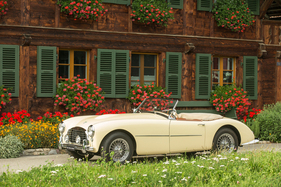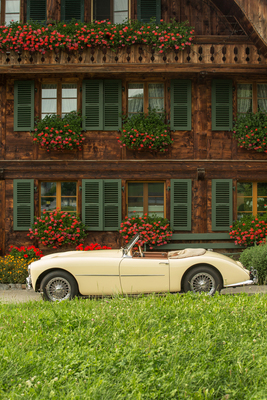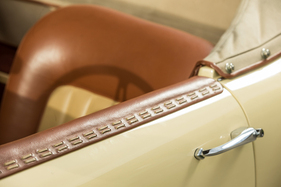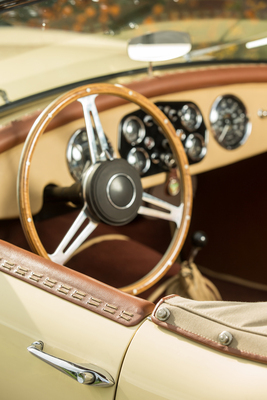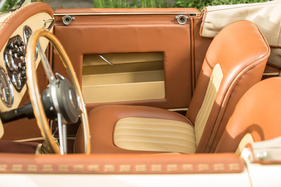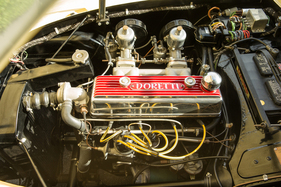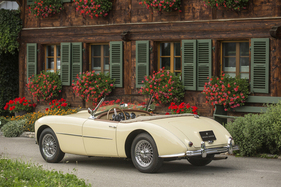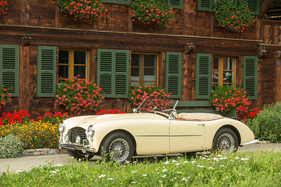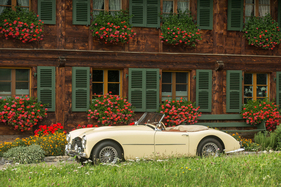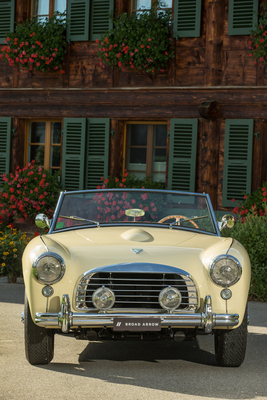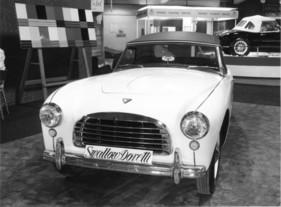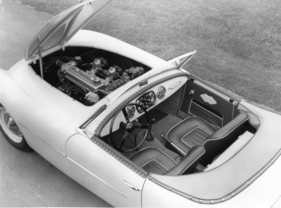Frank Rainbow, who had worked at Bristol Aircraft for many years, was a talented designer. For Swallow Coachbuilding, which emerged from the Swallow Sidecar Company, founded in 1922, and which later became Jaguar, he designed a scooter called the Gadabout, of which around 2000 were produced.
His masterpiece, however, was the Swallow Doretti, a sports car that could comfortably reach 100 miles per hour.
Only for the Americans
In the summer of 1952, Eric Sanders, the head of Swallow Coachbuilding, met with Arthur Anderson, who would have liked to have a sports car for sale in the States. Naturally, Frank Rainbow was entrusted with developing the car.
As Sanders had good relations with Sir John Black of Standard Triumph, the technology was almost automatically predetermined.
Rainbow was given a free hand, but had to deliver a complete first car somewhere between a Triumph TR2 and a Jaguar XK 120 within nine months, a challenge he was up to.
Presentation at the 39th London Motor Show
The car was presented for the first time on January 7, 1954 at the Los Angeles Ambassador Hotel in Gardena, but the British public did not get to see the 100-mile-per-hour sports car until October at the Earls Court Motor Show in London.
There was a great deal of interest in the two Dorettis sprayed in black and white, with Faisal, the King of Iraq, and comedian Bob Hope among those who took a seat behind the wheel of the Swallow Doretti.
More than just an improved TR2
Although the engine, gearbox and suspension came from the Triumph TR2, the chassis and bodywork were completely redesigned and the result had above-average torsional rigidity. The frame consisted of high-quality steel tubes wrapped around two heavily dimensioned side members.
The body was made of steel and aluminum sheets and had a clear weight advantage over the Triumph design, even though the Swallow Doretti sports car was larger and, above all, wider than the Triumph TR2 base.
In fact, the Swallow Doretti measured 3.962 meters in length and 1.549 meters in width, while the TR2 was 3.835 meters long and 1.397 meters wide. Instead of 953 kg, the Doretti only weighed 864 kg.
The 1991 cm3 in-line four-cylinder engine from the TR2 was adopted, which produced 90 hp. Most of the cars were equipped with a four-speed gearbox and Laycock-de Normanville overdrive.
A touch of Ferrari
Frank Rainbow also did a great job with the design. Not unlike an Austin-Healey 100, its design also featured features of the Ferrari 166 MM Barchetta from Touring, but as a Granturismo sports car it was of course designed more for everyday use, although the sales brochure also mentioned possible racing applications.
The name Doretti also sounded Italian, but it was inspired by Dorothy Deen, the daughter of the head of the American dealer network that was to sell the sports car. Dorothy then probably became the better-sounding "Doretti" for a car.
While the first vehicles all went to the USA, from mid-1954 the British were also able to buy a right-hand drive Swallow Doretti for around 777 pounds, while a TR2 cost just over 600 pounds.
Convincing
The 18 men at the factory in Staffordshire were able to build five cars a week, only a few of which ended up as test vehicles. Despite this, a surprising number of reports about the new sports car appeared in the press.
"The Motor" drove a Swallow Doretti as early as the summer of 1954 and recorded an impressive 12.3 seconds for the 0 to 60 miles per hour (96 km/h) sprint, with a top speed of 100.2 MPH (163.3 km/h9).
"As a fully equipped sports car offering comfort, 100 MPH top speed, low running costs and appealing handling characteristics, the Swallow Doretti is an attractive new entrant in the UK and other car markets," wrote the testers, concluding with the hope that Swallow Coachbuilding would continue to develop.
Motor Sports" magazine also drove the elegant Doretti and commented:
"The Doretti is an interesting compromise between a sports car and a roadster. On the one hand, it has hard springs, short gearshifts, bucket seats and relatively little luggage space; on the other hand, it is comfortable, has all-weather characteristics and impresses with its economy."
On the occasion of the test day in Goodwood, Automobil Revue was given the opportunity to try out a black press car:
"Next to the Triumph TR 2, the Swallow-Doretti, which is 152 pounds sterling more expensive, around 70 kg lighter and about 20 cm longer, performs quite well. Thanks to the somewhat stiffer frame, especially at the rear, the road holding seems to be slightly better and the body can almost be described as a convertible. In contrast, the Doretti is somewhat louder and has a less favorable steering angle.
But the deeper meaning of the Swallow-Doretti lies in something else. This two-seater, two-liter car, with its somewhat uncomfortable entry, the short gearshift, the high-revving engine, the hard, almost somewhat bucking suspension and the modest accommodation for luggage, embodies the real English sports car of our day for the real English sports driver, who is happy to put up with a few inconveniences if he can drive a fast, easy-to-handle, precise-steering car in return. Originally, however, this Doretti, which we very quickly became friends with, was not intended for English people at all, but as a pure export product."
Apparently, even the press was not yet sure at the time which markets the car was actually intended for.
Deadly conflict of interest
But none of this mattered, because overriding interests put an end to the small sports car. Jaguar intervened at the level of the Tube Investments Group, the parent company of Swallow Coachbuilding, and gave the group the ultimatum of either stopping production of the sports car or not supplying raw materials to Jaguar.
The management decided not to manufacture any more products that competed with Jaguar. The Doretti Mk II, which had already been further developed and given the name Sabre, never went into production.
High survival rate
A total of 276 cars were produced between 1954 and 1955 (other sources cite 290 vehicles). According to insiders, 170 of these cars are still in existence (other sources also cite lower figures), which would indicate a high survival rate.
Despite their rarity, the prices at which well-preserved examples are traded are limited.
Bonhams is offering the light blue 1955 Swallow Doretti shown here at the Zoute Grand Prix auction for € 55,000 to 70,000 (CHF 55,000 to 77,000).
Further information
- AR-Zeitung No. 47 / 1954 from Nov. 3, 1954 - Page 16: Short tests at the London Motor Show 1954 - Swallow Doretti
- The Motor, September 15, 1954, from page 222: Road Test No 27/54 - Swallow Doretti
- Motor Sport, November 1954, from page 640: The 2-Litre Swallow Doretti (Test)





